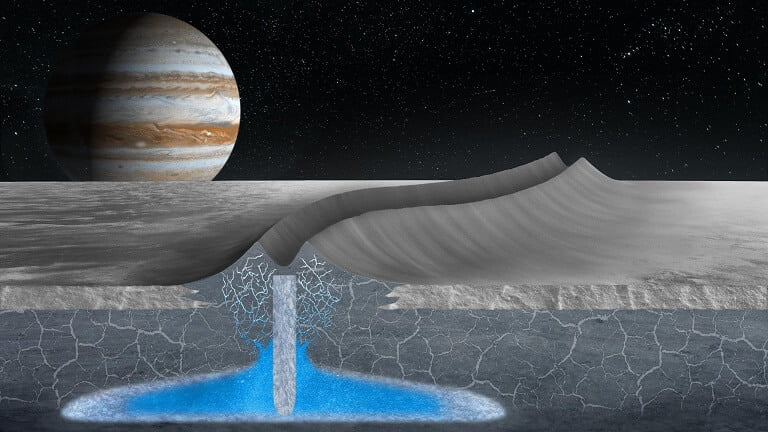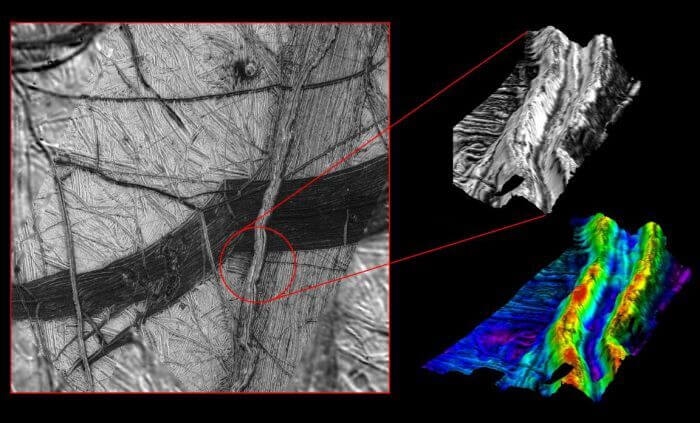
One of The Solar System’s Best Candidates For Alien Life Has Signs of Liquid Water
And there could be life in it.
By Michelle Starr | Science Alert
Strange double ridges on the surface of Jupiter‘s ice moon Europa could be signposts to shallow reservoirs of water.
An analysis of a similar feature on the Greenland ice sheet shows that, here on Earth, these ridges can be created by pockets of liquid water contained within the ice itself.
This finding offers some new insight into the geophysical processes that shape the forbiddingly frozen world. It also suggests that extraterrestrial life, if it exists on the moon, might not be sequestered in an ocean tens of kilometres below Europa’s ice, but may in fact be much closer, within tantalizing reach.
“Because it’s closer to the surface, where you get interesting chemicals from space, other moons and the volcanoes of Io, there’s a possibility that life has a shot if there are pockets of water in the shell,” said geophysicist Dustin Schroeder of Stanford University.
“If the mechanism we see in Greenland is how these things happen on Europa, it suggests there’s water everywhere.”
Europa is riddled with enigmas, in its distant home orbiting the largest planet in the Solar System. Evidence suggests that the frigid body isn’t completely frozen, but harbours a liquid, briny ocean warmed by internal geological processes beneath its thick shell of ice.
It’s been identified as the best place in the Solar System to look for extraterrestrial life, clustered around volcanic ocean-floor vents like those here on Earth.
We don’t, however, know much about the moon. For example, its surface is scored with enormous double ridges, which run along either side of long troughs. How these form has been a mystery since they were first discovered in images taken by the Galileo probe in the 1990s.

As is so often the case in science, happenstance may have given us an answer.
Schroeder and his colleagues, geophysicists Riley Culberg of Stanford (who led the study) and Gregor Steinbrügge of NASA’s Jet Propulsion Laboratory, attended a presentation on Europa and noticed that the double ridges were strangely familiar.
They looked awfully like giant versions of ridges they’d observed on Greenland’s glacier during an unrelated project.
“People have been studying these double ridges for over 20 years now, but this is the first time we were actually able to watch something similar on Earth and see nature work out its magic,” Steinbrügge said.
“We are making a much bigger step into the direction of understanding what processes actually dominate the physics and the dynamics of Europa’s ice shell.”
Although much smaller than the features on Europa, the Greenland ridges appeared to be pretty much the same. So the team set about investigating how the Greenland ridges formed.
They studied data collected by NASA’s Operation IceBridge, which uses radar technology to see what’s happening beneath the ice. The team’s data started in 2015, at which point the ridges had not formed, until 2017, after they had appeared.
These data revealed that the ridges in Greenland formed when a pocket of pressurized water refreezing inside the ice sheet caused the ice sheet to fracture. This produced the double-peaked M shaped-feature in the ice – and it’s eminently possible that similar processes have been taking place on Europa, the team said.
“In Greenland, this double ridge formed in a place where water from surface lakes and streams frequently drains into the near-surface and refreezes,” Culberg explained.
“One way that similar shallow water pockets could form on Europa might be through water from the subsurface ocean being forced up into the ice shell through fractures – and that would suggest there could be a reasonable amount of exchange happening inside of the ice shell.”
It also suggests that shallow water, and the processes thereof, may be ubiquitous across the surface of Europa, in time as well as space – that liquid water is, and has been, pervasive within the shell of ice that wraps around the moon, shaping its strange geography.
This could have implications for searching for life on the alien world, but we won’t know more until radar-equipped spacecraft can take observations from Europa’s orbit, to compare against the Greenland radar data. Luckily, two missions to explore the moon are soon to launch, ESA’s JUICE and NASA’s Europa Clipper, both carrying ice-penetrating radar.
They should reveal more about what causes the strange, double-ridged gouges all over the surface of the icy moon.
“We are another hypothesis on top of many – we just have the advantage that our hypothesis has some observations from the formation of a similar feature on Earth to back it up,” Culberg said. “It’s opening up all these new possibilities for a very exciting discovery.”
The research has been published in Nature Communications.
This article was originally published by Science Alert.
